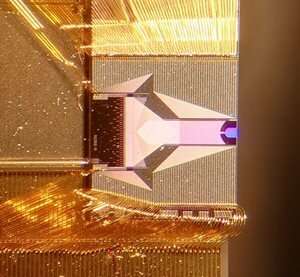New progress toward chip-based ghost imaging

For the first time, researchers have shown that the non-conventional imaging method known as ghost imaging can be performed using a low-cost, chip-based light-illuminating device. This important step toward chip-based ghost imaging could make the imaging method practical for applications such as chip-scale biomedical imaging, light detection and ranging (LIDAR), and internet-of-things sensing devices.
There is a great deal of interest in ghost imaging because it can be performed with a low-cost single-pixel detector instead of a complex, and typically expensive, camera. When combined with the compressed sensing computational approach, ghost imaging can also achieve higher sensitivity and faster imaging than traditional methods, especially in non-visible wavelength ranges.
In The Optical Society (OSA) journal Optics Express, researchers from the University of Tokyo describe how they replaced a bulky optical component typically used for ghost imaging with a newly developed chip-based optical phased array (OPA) that measures only 4 by 4 millimeters.
"If low-cost, single-chip imaging devices were commercialized it would enable low-cost LIDAR, which is the technology self-driving cars, drones and autonomous robots use to see their environment," said Takuo Tanemura, who led the research team. "Also, small imaging devices could be embedded into smartphones to allow improved 3-D imaging and healthcare monitoring."
Faster, lower-cost imaging
Ghost imaging works by illuminating an object with random speckle patterns that change over time. Correlating the transmitted (or reflected) optical power that travels through the object with the intensity distribution of the speckle patterns allows an image of the object to be obtained.
Although this imaging approach was proposed more than 10 years ago, the bulky and slow spatial light modulators used to generate the speckle illumination patterns have kept ghost imaging mostly constrained to the laboratory.
In the new work, the researchers overcame an inherent challenge to applying large-scale OPAs, which use an array of adjustable integrated waveguide elements to control the phase of light. Instead of trying to align all the optical phases precisely, which is challenging in practice, they designed an OPA in which the phase-controlling elements operate randomly. This allowed them to generate randomly changing speckle patterns that were perfect for ghost imaging.
"Compared with previous implementations of ghost imaging using spatial lightwave modulators that were large and slow (typically operating in the kilohertz range), using an integrated phased array is much more compact and offers lower cost," said Tanemura. "Our approach also has the potential to reach greater than gigahertz operational speeds, or six orders of magnitude faster than SLM-based approaches."
To create the random speckle pattern, the researchers applied rapidly changing random electrical signals to 128 integrated phase shifter elements on the OPA. They demonstrated 2-D imaging with more than 90 resolvable points in the X direction (determined by the number of phase shifters) and 14 pixels in the Y direction (determined by the number of wavelengths tested). The results agreed well with theoretical predictions.
Smaller, cheaper LIDAR
"This type of imaging device could be particularly useful for LIDAR, which currently produces 3-D images using a bulky mechanical mirror to steer a laser beam," said Tanemura. "It is estimated that the cost, size and response time of LIDAR needs to be reduced by 1 to 2 orders of magnitude to be widely deployed in non-luxury mass-market cars. A chip-scale ghost imaging device could accomplish this."
The researchers will continue working to make the new technology even more practical. They are experimenting with electro-optic phase shifters that could increase OPA operation to speeds beyond gigahertz. They also plan to further increase the scan rate and would like to integrate all the optical components on the same chip as the OPA to accomplish 2-D and 3-D imaging without any off-chip components.
"If we're able to integrate all the necessary components, including the light source and detector, on a chip, then a single-chip ghost imaging device would be possible," said Tanemura.
More information: Yusuke Kohno et al, Ghost imaging using a large-scale silicon photonic phased array chip, Optics Express (2019). DOI: 10.1364/OE.27.003817
Journal information: Optics Express
Provided by Optical Society of America



















